Bob Foose, Todd Dunivant reveal new details on 'best deal' for MLS CBA

On Tuesday evening, with collective bargaining negotiations between MLS executives and owners and the union having stalled, the players voted overwhelmingly to strike.
“We were willing to walk and go into that abyss of the strike. It’s a huge, heavy decision,” said LA Galaxy defender Todd Dunivant, one of five members of the union’s executive board. “We had a deal in front of us that we just didn’t like. It was clear that we weren’t going to take it and there was a big decision to make and we made a big decision. For about two or three hours after that, we thought we were finished. We thought our work was done.”
MLS player involved in CBA talks says many 'upset,' 'disappointed' with deal
But it wasn’t. Federal mediators, who’d been shuttling back and forth between the sides inside the U.S. Federal Mediation and Conciliation Service headquarters in downtown Washington D.C., informed the players that MLS wanted to continue to negotiate. They did so until around 6 a.m. Wednesday. By that evening, the two sides agreed on the terms of a collective bargaining agreement that saved the 2015 season and, the union hopes, will eventually alter the complexion of the league.
“Having a second chance to do that was encouraging,” Dunivant told SI.com.
There is no perfect deal, of course, and it’s often said that an agreement is fair if both sides walk away unhappy about something. The five-year CBA, which still must be drawn up and ratified by both sides, left a significant chunk of the union’s bargaining committee dissatisfied. Goal.com reported this week that representatives from seven clubs voted against it, and several players vented their frustration anonymously in the press. The diversity of ideas the union wanted to bring to the bargaining table inevitably meant there’d be a wide range of opinions as well, and passions were high.
“It was intense. It’s very intense. It’s very emotional, because there’s a lot at stake,” Dunivant said. “I wish we were all millionaires. No matter what deal you’re negotiating, even if you’re negotiating on the street for a piece of fruit, you always wonder if you could’ve gotten it for less or found a better deal. Ultimately, the deal we took was, in my mind and in the majority of guys’ minds, the best deal we could’ve received. That’s our job, to get the absolute best offer in front of us. It’s not the offer you think is fair. It’s not the offer you think we deserve. It’s ‘What is their best offer,’ and that’s what we had in front of us. I can say that with 100% certainty.”
• STRAUS: What is at stake in MLS' CBA negotiations?
The league’s “best offer” included a provision that was crucial for the players—free agency. In fact, they said they weren’t taking the field without it. Since the league’s first season in 1996, executives and owners have maintained that free agency is antithetical to a business that survived, and in some ways is now thriving, because of centralized cost control. MLS didn’t want owners bidding against each other for players, thereby boosting salaries beyond what the league considered to be market value. Every dollar was precious.
But the players felt the same way about having a bit more say in their own careers. And on Wednesday, they secured some of that say. Now, players at least 28-years-old with eight years of MLS service will enjoy restricted free agency when their contracts expire. They can bargain with teams of their choosing, while the owners maintain some cost certainty. Players earning less than $100,000 per year will be limited to a 25% raise, players earning $100,000-$200,000 to a 20% raise and players earning more than $200,000 to a 15% raise. The league and union also agreed to a provision under which players deemed to be “vastly outperforming their contract”—a neutral or third party will make that determination—won’t be restricted by the aforementioned cap on raises. The re-entry draft—the 2010 CBA compromise that allows players with expired contracts or declined options to move to an interested club that selects them—will remain.
Robbie Keane voices support of MLS players strike in pursuit of free agency
“That’s the groundbreaking part of this deal for us and that’s what will ultimately lead to really substantial and real positive change for this league. That, despite the fact that what we heard consistently through the process was that [free agency] would never happen,” MLSPU executive director Bob Foose told SI.com.
“That’s a very, very good start for us. And we did in 12 years. That’s something I don’t want to be lost on anyone. We’re 12 years into this union and we’ve been able to introduce some free agency… none of the other major leagues has ever done it anywhere near that quickly in North America.”
Nor have those leagues introduced free agency without a work stoppage or litigation. The players, many of whom would have had some difficulty dealing with a protracted strike, consider that a win.
The 28/8 free agency term will impact about 12.5% of the player pool directly, Foose said. But many more will see some benefit.
“From the most basic perspective, it’s about player choice. But the impact of this that won’t be seen or reported on is, number one, the deals that are going to get done between the players and their current clubs are going to change because those players have the ability to leave at the end of their contract,” Foose explained. “Number two, it’s no longer going to be a viable strategy for a team in this league to have its players feel as through they’re not being treated fairly. If they do that, it’s going to have an impact on the club. Frankly those things will have a more substantial affect on this league, by far, then counting the number of players who actually change teams.”
Said Dunivant, “It’s all a matter of degree and we got a restricted free agency system that will improve the players’ lives by leaps and bounds. It’s a massive step forward. To get free agency as we did, I don’t think any league in North America has gotten any kind of free agency on their first go-around introducing it in their 20s. We got it at 28. That’s a huge accomplishment.”
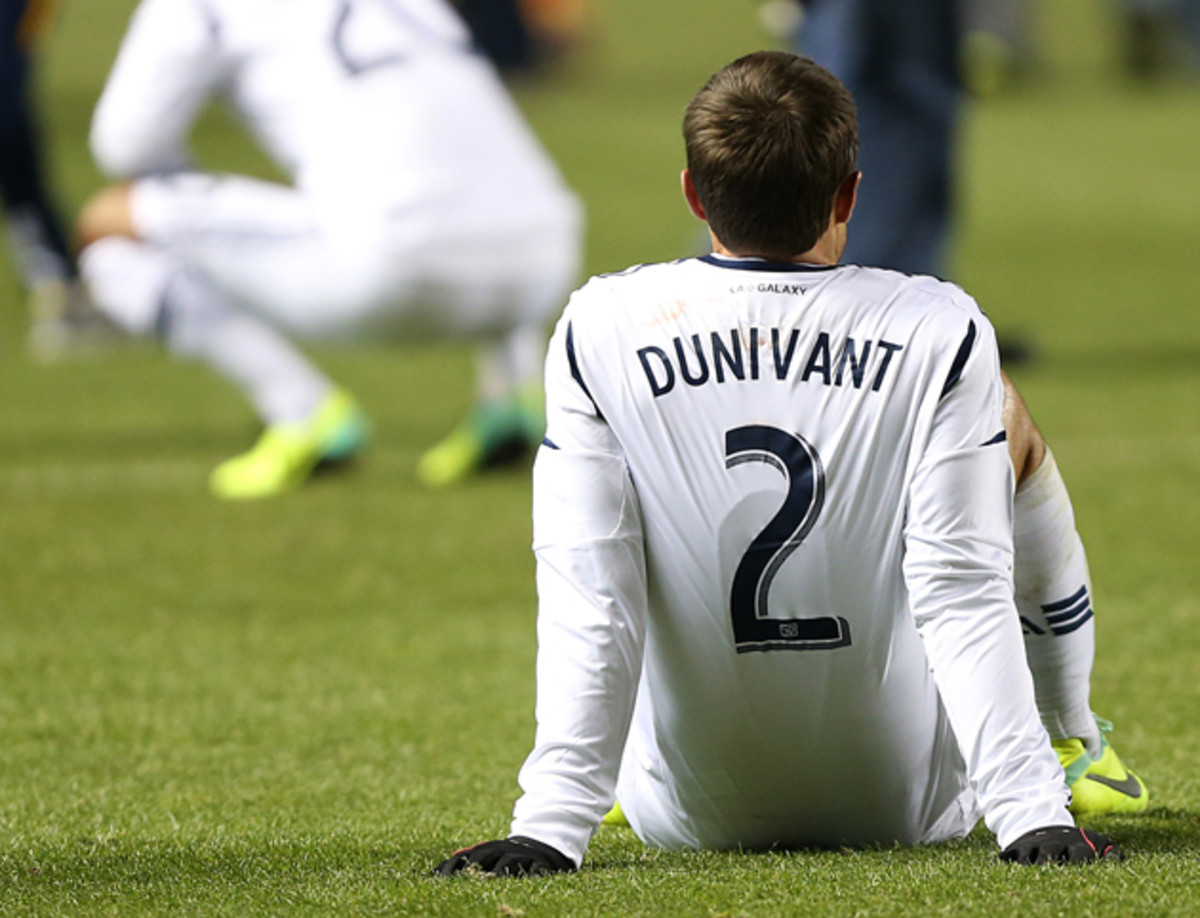
There were other gains as well, from minimal to significant. The salary budget, which was $3.1 million last season (designated players over age 23 counted $387,500 against the budget), will increase roughly 20 percent in 2015 and then by seven percent annually through 2019, Dunivant said. There will still be three DP slots per club. The minimum salary for senior roster players, which was an embarrassing $48,500 in 2014, will increase to $60,000 this year and up to at least $70,000 by 2019. It’s still low by pro sports standards, but it will allow young players to focus on their craft rather than on how to make ends meet. Roster sizes will drop from 30 to 28, with a number of junior players who don’t count against the cap making a bit less than $60,000.
The CBA’s length also was a major sticking point and, in fact, was a key driver of Tuesday’s strike vote. The league insisted on an eight-year deal to coincide with the TV contracts signed with ESPN and Fox. The players wanted five years. And they got it.
Robbie Keane voices support of MLS players strike in pursuit of free agency
“We were told consistently through the process that there would be no deal that wasn’t eight years—all the way until Wednesday,” Foose said. “It changed everything. To be able to limit it to five, to get started on a system of free agency so we could go back to the table and make further improvements in five years, was massive.”
These collective bargaining sessions were painted by many, in broad strokes, as a test for the league’s single entity structure, under which club owners actually are investors in one company that collectively owns and negotiates contracts. MLS insists that structure is necessary to survive and then grow in a unique environment, where soccer is under pressure from the more popular sports in the U.S. and Canada and by the more established leagues in Europe. Opponents, meanwhile, argue that single entity is part of the problem. It restricts ambition and independence, limits spending and prevents MLS from reaching its potential.
That big-picture debate wasn’t an issue this winter, Foose said.
“We didn’t seek to dictate, nor do we need to dictate, how they structure their business. ‘Single entity’ is a loaded term and I think the reality is more complex than just that term. So it was important for us not to couch this as any attempt to dictate to this group of owners how they structure their business and frankly, we don’t need to,” he said. “We don’t need to be trying to dictate things that don’t impact the players....Free agency is not incongruous with single entity. We just proved that.”
Naturally, there were players in the room who wanted more. Some wanted to strike. Perhaps some wanted to divide the owners and contest the very nature of MLS’ business. Dunivant said the deal they negotiated on Wednesday and the potential cost of a work stoppage, to both the player pool and the league, were weighed carefully.
MLS at 20: Epic original branding, logos for the league's first 10 teams
“You don’t just strike for a week and come back and say, ‘I know we missed the first week of the season, but let’s just put that behind us and I’ll take that deal you offered a week ago,’” the veteran defender said. “The next deal they put in front of you is going to be worse. That’s the risk of a strike.”
Dunivant continued, “Our role is to find the best deal. Whether it’s now, whether it’s after a strike, at some point you’re signing a deal. The process to get there is very difficult and you can ask any of the guys who were there—it was emotionally and physically draining and taxing. It’s part of the process, and it’s like that because there are so many viewpoints and so many different ways of thinking. It’s a process that works, though. It gets you to a point where you make decisions as a group, and that’s what we did.”
Dunivant said he was certain the union got the best deal possible. Where MLS had been intransigent, it now showed some flexibility. Players won free agency. Minimum salaries rose. There was incremental progress elsewhere and there will be a chance in five years to make more. Just as importantly, the union avoided a strike that, had it lasted long enough, may have damaged the league and hurt the portion of the pool that earns lower salaries.
“It’s not perfect. I’m not going to stand here and say ‘It’s perfect.’ Our expectations were extremely high and we didn’t meet all of them. There’s going to be some disappointment. But that’s a part of the process and at the end of the day, it’s a good deal for us,” Foose concluded. “I couldn’t be more proud of the bargaining committee and how they did their jobs. They represented every member of the player pool effectively. They discussed every issue in incredible detail, and every side of every issue. When they disagreed, they did it respectfully in every single instance throughout a very intense process. They did their job and they did it well.”
GALLERY: Critiquing the full 2015 MLS uniforms
Critiquing every MLS uniform, head to toe
New York City FC
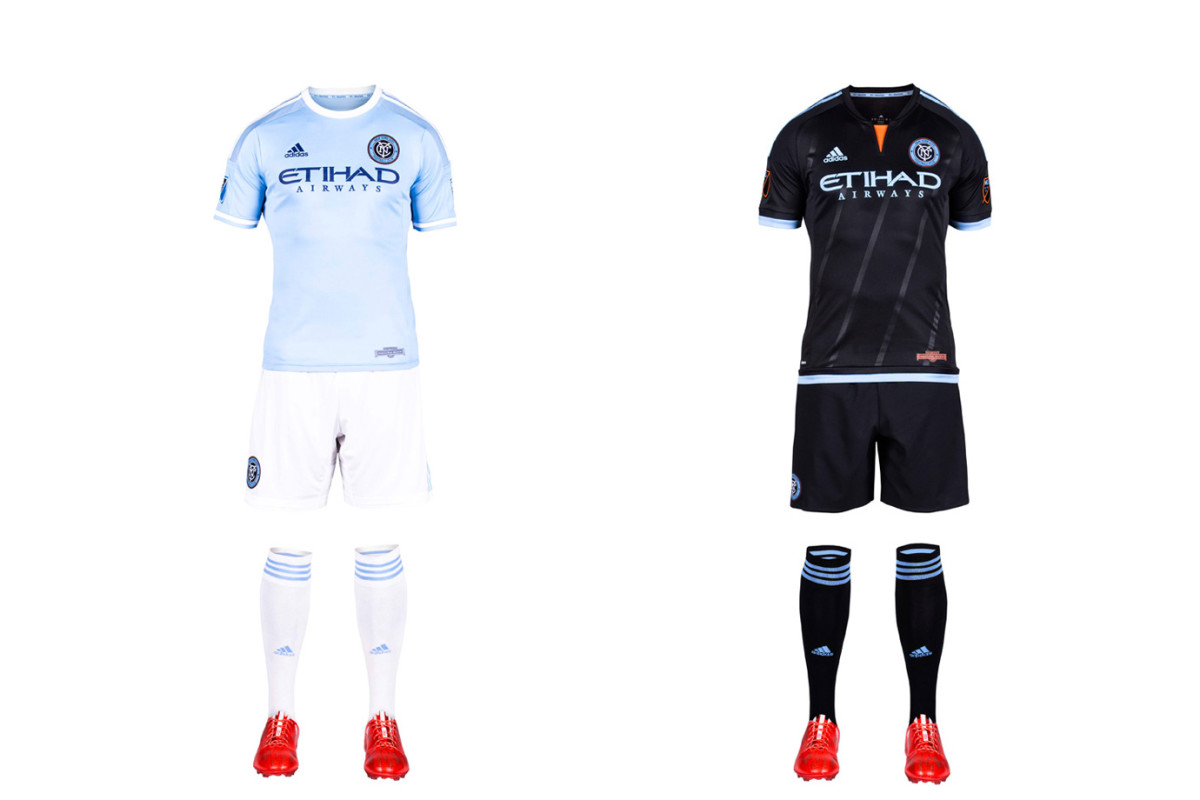
New York City FC took some heat for its sky blue home shirt, which looks a whole lot like the one worn by parent/sister club Manchester City. But an homage was inevitable, and NYCFC has differentiated itself from MCFC, and the rest of MLS, with the white shorts and socks. It’s a sharp look. The away kit, highlighted by a flash of orange (from the city flag) at the neck and five stripes you can barely see that "represent the five boroughs of New York City," is lazy. With a blank template, NYCFC should’ve come up with something other than the mono-black already worn in D.C. and Columbus.
LA Galaxy

After several overhauls—LA wore black and teal, then teal and yellow, then yellow and green—the Galaxy’s white and blue brand has taken root. Three championships in four years certainly help. The sash on the home uniform, re-introduced in 2012, has quickly become iconic, and, along with the socks, helps make this all-white kit stand out. The new secondary set maintains the same feel as its recent predecessors. The yellow accents look sharp, but we can’t help but feel a white or yellow sash would tie the uniforms and brand together.
Chicago Fire

Of the four MLS teams with an all-red home uniform (that’s 20 percent of the league), the Fire were first. They’re the “Men in Red,” after all. But Chicago began veering away from its traditional look in 2012. First the famous white hoop became blue. Then last year, the blue expanded to the chest and shoulders. It doesn’t look bad, but it doesn’t seem right, either. The new away kit is another all-white offering. But at least designers put a bit of thought into this one. The thin, light blue hoops on the shirt and socks, intended to reflect the design of the city flag, are a nice touch.
Montreal Impact
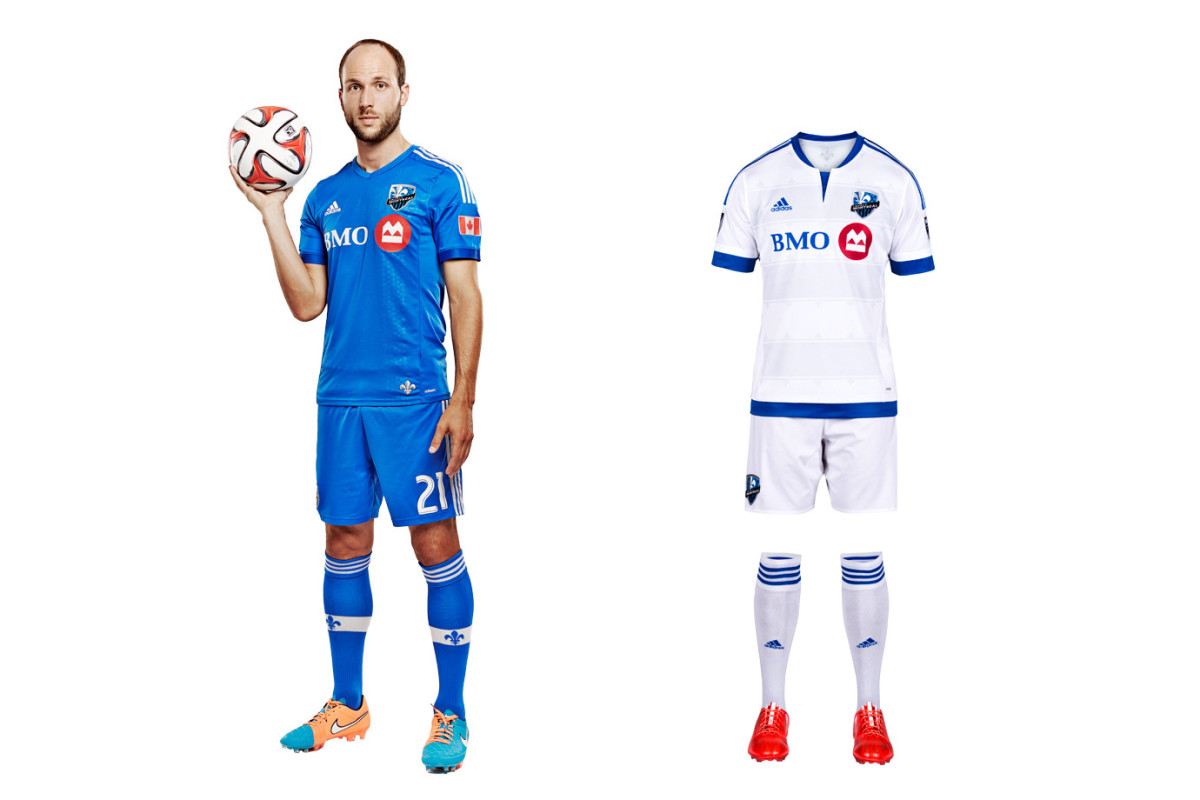
Montreal exemplifies MLS/Adidas’ fixation on tiny details rather than the impact (sorry) a uniform makes when viewed from more than three feet away, which is where most people watch a game. The new away kit features a tiny silver fleur-de-lis affixed to the back and more woven subtly into the fabric. But overall, it’s just another anonymous all-white uniform that mirrors the existing, plain blue primary set. The tragedy is that Montreal’s gorgeous blue-and-black striped alternate, which would be the only striped kit in MLS, is gathering dust. It should be the club’s primary.
D.C. United
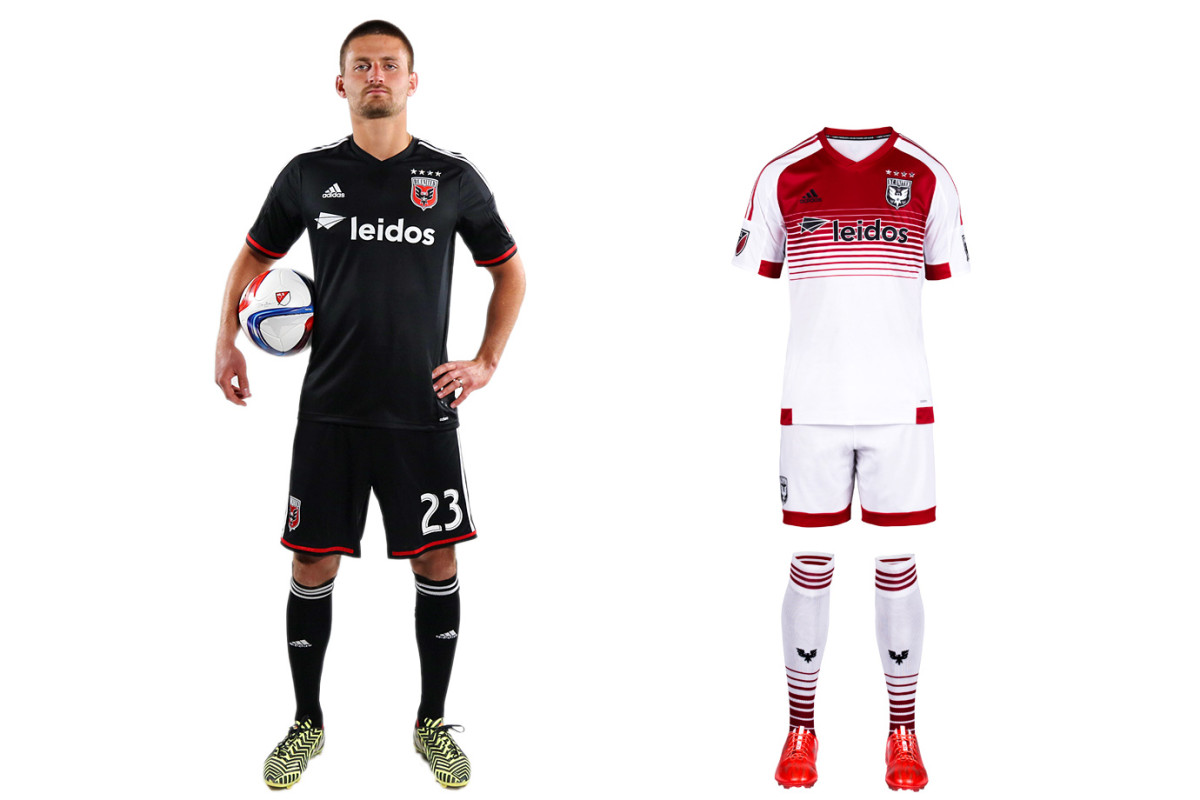
D.C. United calls itself the “Black and Red,” but its uniform palette typically has ignored the latter. That’s been rectified with the club’s new secondary kit, which features a welcome splash of red on the traditional white jersey. The home uniform, which carries over from 2014, still looks unfinished without the white chest stripes that were dropped in 2008. If D.C. could find a way to re-introduce them, perhaps above the sponsor logo and behind the crest, it once again would boast one of the sport’s most distinctive designs.
Real Salt Lake

RSL stubbornly refuses to look great. It took a small step forward with its new secondary uniform, which now features two blue sleeves. It's too bad there isn’t even more of RSL’s beautiful claret, cobalt, and gold color scheme in the kit. The red home set carries over from 2014, making it six seasons since RSL abandoned the claret shirt, cobalt shorts/socks combo it wore when winning its only MLS title. The yellow chest stripe adds a little something extra, but RSL’s preference for an all-red kit similar to others around the league instead of a classy, one-of-a-kind look with championship pedigree is baffling.
Toronto FC
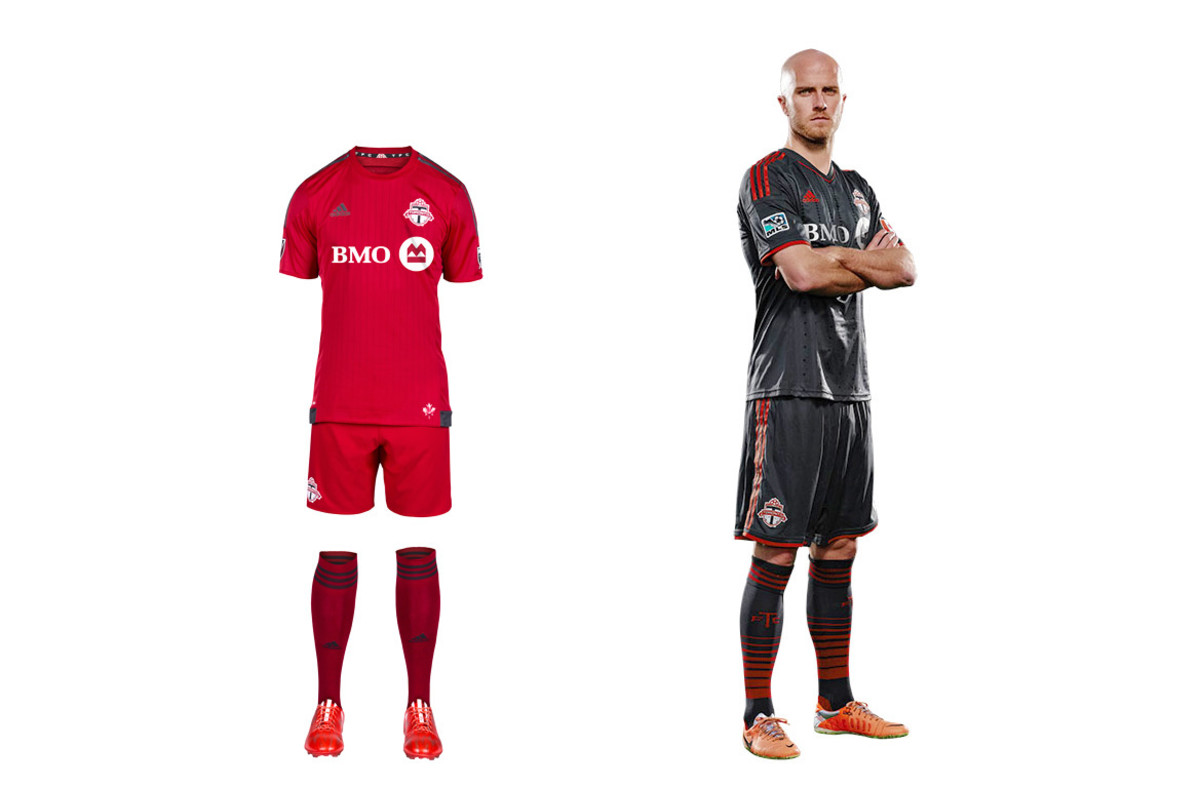
Toronto FC’s new home set could be the reddest uniform in the history of a league that loves red uniforms, which we suppose is noteworthy (guess Adidas insisted on the contrasting three stripes). Club management has focused on building a team capable of ending an eight-year playoff drought, likely leaving little time for kit design. The holdover secondary set is charcoal gray, which features in the TFC logo and is a unique uniform color in MLS. The hooped socks finish off a striking look and make us wish there was a bit more gray in the primary.
New England Revolution

The Revs are Exhibit A for the effect a second color, even if it comes from something as mundane as a plain pair of shorts, has on a club’s brand. Long a believer in boring, N.E. last year overhauled its home blues with white shorts and hooped socks. It’s a classy yet instantly recognizable look. The image shake-up continued Tuesday with a new secondary kit inspired by the regional flag flown during the American Revolution. The red-and-white set is clunky and geometric, but it’s different, daring and local. Better to take a chance than look dull and anonymous.
Philadelphia Union

The Union got it right in 2010. The inaugural navy kit with the gold center stripe, reflecting the Philadelphia flag, was iconic. The gold-and-blue away set, a reversal of the primary, was one-of-a-kind. The holdover home uniform still looks great, although the sponsor’s logo wrecks the balance. But the new secondary is a disaster, a needless departure from the brand and an 10th all-white MLS kit. Once innovators, the Union are now followers. The “WE ARE ONE” collar slogan, the tiny snake below the neckline and the embossed stars on the front are lost in a sea of white.
Vancouver Whitecaps

The Vancouver Whitecaps new primary uniform is meant to be experienced up close. It’s slogan heavy. “Our All. Our Honour.” appears inside the neck and on the hip. “SINCE 1974” is on the back. The thin, diagonal pinstripes that featured on the previous home kit have been replaced by light blue shading designed to represent Vancouver’s water and mountains. It’s all a bit too subtle. The shirt will look nice with jeans, but in the end, Vancouver’s all-white kit—and the holdover mono-navy secondary—simply blends in.
Portland Timbers

Portland quietly switched crests, from a logo featuring its name to a simpler version focusing on the axe and chevrons (the old logo lives on elsewhere). Few teams wear a badge with no writing, but the Timbers can because they’ve built such a powerful brand. Only they could wear the new home set, a bold green-and-white offering anchored by the chevrons. They're a bit wide, and the yellow below the collar clutters the shirt, but it's impressive overall. The road kit, released in 2014, is everything a good one should be: distinctive, perhaps edgy, yet connected to the club. In this case, Rose City red.
Columbus Crew

The Crew released new home and away sets featuring the club’s revamped logo, a roundel that looks nice enough but makes sense only with a cheat sheet. The explanations (the ‘O’ for Ohio, the founding year, the checkerboard pattern found in flags waived by fans) certainly tie the club to Columbus more than the goofy construction workers did. As the Crew forge ahead, they’ll stay true to their sartorial tradition. The all-yellow primary is simple but elegant, and certainly recognizable. The mono black secondary could use a bit of flourish–why so subtle with the checkers? But it works and shouldn't be needed that often, anyway.
Orlando City SC

The Lions’ love for purple is welcome in a league featuring so many similar looks. But it didn't result in creative inaugural kits. The home uniform features more up-close details, like “jacquard engineered banding…representing Orlando City’s transition to a new era” and even the club's old USL logo inside. The mono-white secondary has colored hoops on the waist and sleeves and includes more small symbols and slogans. But it’s still just another white set. The answer is obvious—swap the socks. The “Chelsea” look is underrated. White hosiery at home and purple on the road would make all the difference.
New York Red Bulls
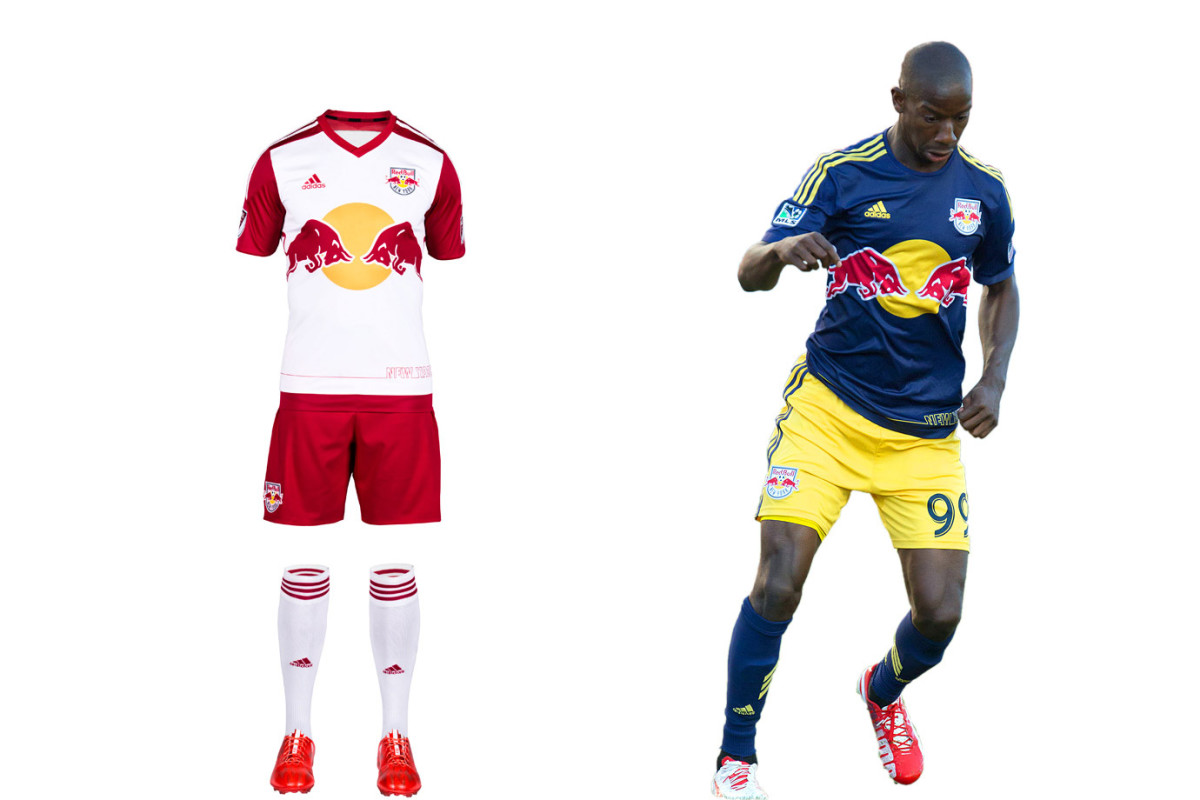
The Red Bulls have company in New York so have set out to reinforce their tenuous connection to the market within the constraints of the club’s corporate brand. The only white-red-white team in the league, RBNY now must compete with NYCFC’s pale blue. The Red Bulls’ new home set doubles down on that contrast with red sleeves and “NEW YORK” emblazoned on the shirt’s lower left in a manner “mimicking the iconic New York skyline.” The “EST.1996” on the back collar reminds fans who was there (or nearby) first. The holdover secondary definitely is unique and is great in reasonable doses.
Houston Dynamo
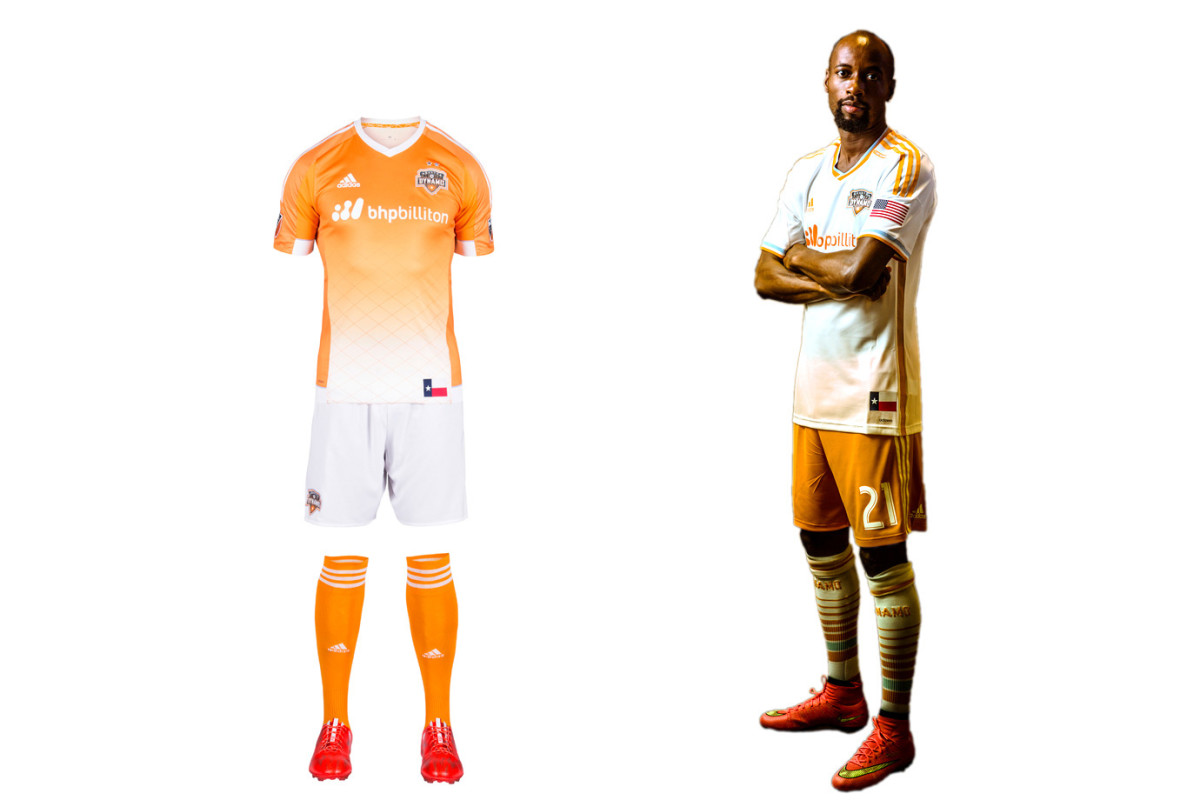
Houston’s club motto is “Forever Orange,” and while that remains the cornerstone of the brand, the Dynamo typically add a wrinkle here and there to ensure we’re not beaten over the head with it. The new home uniform is a great example. The white shorts and checkered fade on the jersey add the right amount of contrast. On occasion, the Dynamo have worn monochrome both home and away. But there’s no need to do so, especially on the road. The balance in the primary kit and the immediately identifiable orange shorts with the secondary set showcase the Dynamo at their best.
Sporting Kansas City

From irrelevant to trendsetting, SKC has profited from one of the most successful sports rebrands in recent history. The club now must share light blue with NYCFC, but Sporting still stands out. The new home set is a departure form the bicolor “state line” uniform of 2013-14 and is anchored by a “fashion-forward window pane pattern” that’s almost as preppy as the recent argyle alternate kit. The secondary uniform is stunning. The hoops, which mirror the stripes on the club crest, highlight one of the most eye-catching sets in MLS history. It’ll be tough to see it go after this season.
FC Dallas
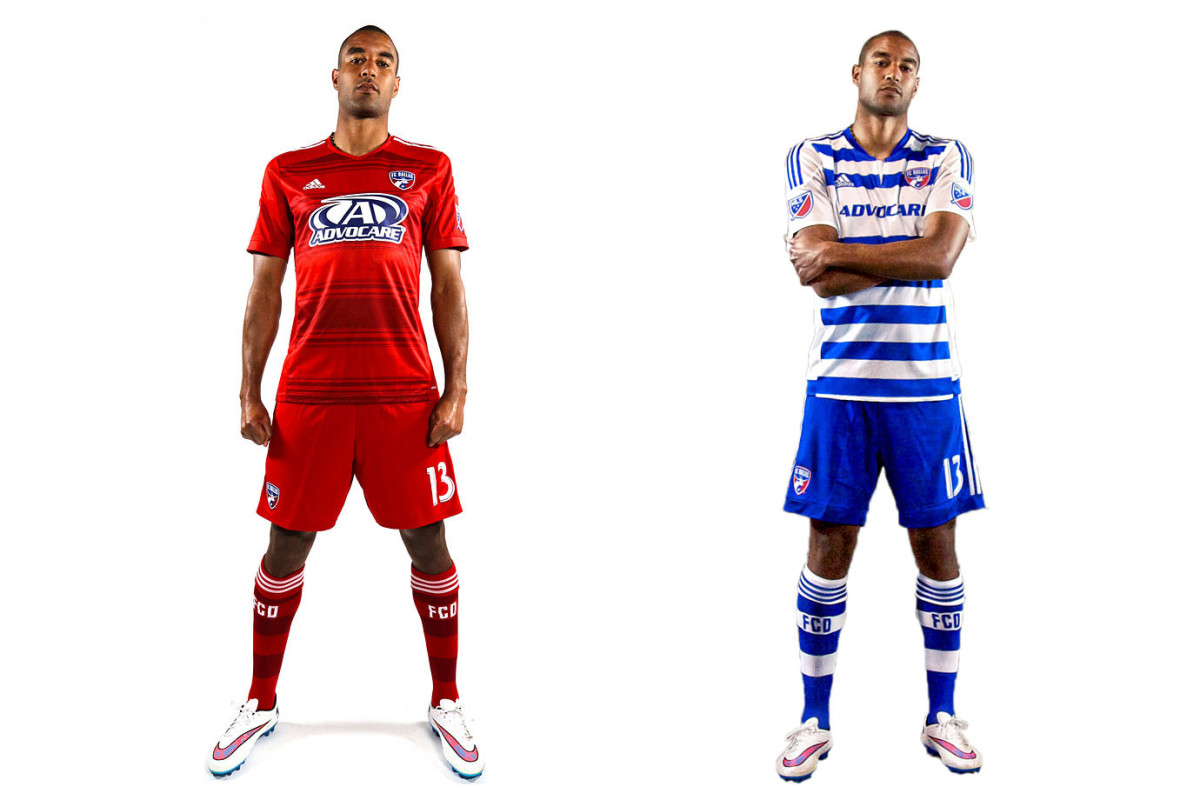
FCD’s kits are an example of a good idea, poorly executed. The club made an inspired decision to go with hoops when rebranding in 2005, but the jerseys always let them down. Unnecessary seams, plackets and panels always ruined the shirt. Dallas gave up last year and went with a boring all-red primary. But it stuck with the hoops on the new blue-and-white secondary, where the side panels and sleeves still disrupt the flow. Both blue and white shorts are an option. Our 2016 ideal: a primary jersey with seamless, sleek red and blue hoops. Unique and colorful, but less jarring. Make it happen.
Colorado Rapids

Another club that’s bounced from brand to brand (green-and-white, blue-and-black), the Rapids have settled in nicely with the unique but elegant burgundy-shirt, white-shorts combo. The sleeves, which mirror those worn by sister club Arsenal, add a subtle touch of flair. The new away uniform is a prime example of how a secondary kit can be tasteful and connect to a club’s brand. Last season’s mono blue state-flag set has evolved into a sharp gold-and-blue kit that maintains Colorado's colors and stands out from the crowd. We’re not fans of recolored badges—logos should be sacrosanct—but overall it’s a winner.
Seattle Sounders
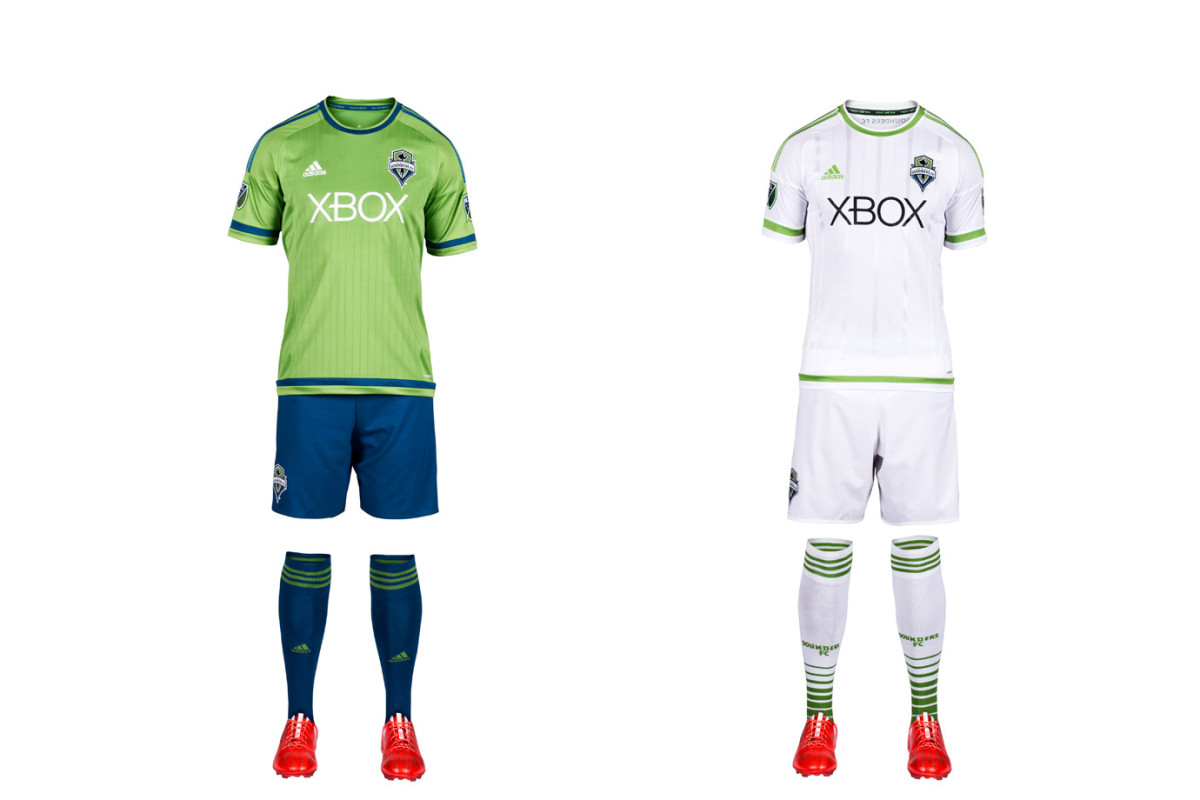
The club that brought us rave green, cascade shale, super cyan and electricity has succumbed to the all-white virus. Seattle is one of five MLS clubs to adopt the look this season, ensuring half the league now embraces the white-out copout. The Sounders new away kit is especially devoid of any personality—a surprising choice for a club that has much of it. The new home set features a less cluttered shirt than in seasons past. It’s a template, but it’s a step up. The uniform also features blue shorts and socks for the first time. Here’s hoping we see it as often as possible.
San Jose Earthquakes

"Earthquakes" is an appropriate moniker for a club that’s experienced so much upheaval. While the new Avaya Stadium offers stability, the brand remains in flux. SJ’s '14 overhaul produced a beautiful blue-and-black primary kit that’s already a modern classic. But the logo, awkwardly anchored by “Quakes”—a nickname of a nickname—lacks gravitas. We liked the re-introduction of the NASL-era red, which inspired last year’s away kit. That’s been replaced by a new white secondary set (yes, another one). It lacks the creativity, individuality and ambition that should be associated with a Bay Area club on the rise.
